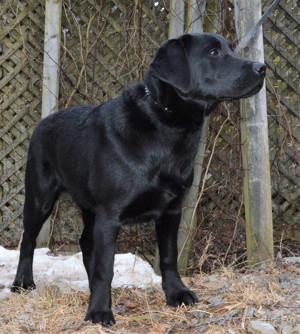Working vs. Show Dogs (conformation requirements)
by Dr. B.W. Ziessow
I am frequently asked the question - - "Are the conformation requirements the same for a working dog and a show dog?"
Many years ago someone asked my long respected all-breed judge, the late Louis Muir the same question. He responded that both the field dog and show dog should have exactly the same conformation and condition.
If one were to examine the history of the Labrador Retriever, he would find the dog was bred with one purpose in mind - to be a working retriever. This was true in Newfoundland where the fishermen carried a Labrador Retriever in the dory to retrieve fish that came off the trawl. Their hunting and retrieving ability was the reason the breed was imported to England by sportsmen in the early nineteenth century. It is also the reason why gentlemen and lady sportsmen brought the dog into this country.
By definition, conformation in any breed is the symmetrical formation and arrangement of (body) parts; conforming to a model or a plan (i.e., the breed standard). The first question that must come to mind in judging any breed or evaluating an individual specimen is "Can the dog do the job he was originally intended to do?" It is axiomatic that proper conformation is basic to the survival of any breed and is equally important to both the show dog and the hunter. It is ludicrous therefore, to think of type as something extra to breed conformation and/or soundness (which is tantamount to proper movement). Without them you can't have true breed type. Accordingly, there is one (and only one) correct type of Labrador Retriever.
The ideal Labrador, and I say ideal because the perfect specimen hasn't been born, should, in my opinion, possess the conformation of a retrieving gun dog able to excel in field work, the quality to win in the show ring, the substance and soundness to hunt upland game and water fowl for long hours under difficult conditions, and the disposition to be a faithful companion and family friend. In all, the physical features and mental characteristics should denote the work the dog was bred to perform.
It is important to remember conformation is not a quality which is either entirely present or entirely absent. There are many degrees of conformation. The problem that faces the Labrador Retriever (and many other breeds) today is to define what degree of variation from the standard of perfection is acceptable for ourselves and, therefore, for the breed. It is most unfortunate, but true, there are many people in the dog fancy today that have the mistaken idea that the ideal specimen of the breed is what is winning at Dog Shows or successfully competing in Field Trials, as opposed to the characteristics that were essential in the development of the breed. This false notion has led to the demise of many sporting breeds as working dogs - - while capable of winning ribbons at dog shows, they are unable physically to do the job the breed was originally intended to perform, they are lacking in those features which formed the basis for the breed conformation and standard. Equally disturbing are the number of dogs being run in field trials (and used for breeding) that do not come up to the breed standards of conformation and soundness.
by Dr. B.W. Ziessow 9-1-90



